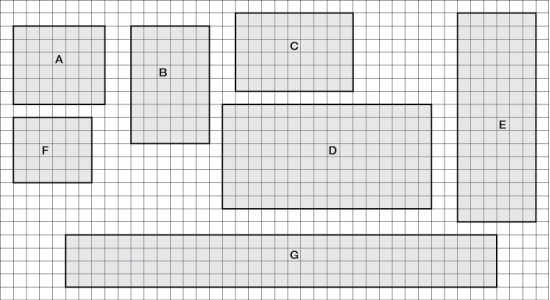Refer to the figure.
Figure 1
 You are working with a town to develop a conservation strategy for parks (tracts) of protected land in a suburban area (parks A-G). These seven areas are depicted in Figure 1. Each square in the grid indicates an area of 1 km2.
You are working with a town to develop a conservation strategy for parks (tracts) of protected land in a suburban area (parks A-G). These seven areas are depicted in Figure 1. Each square in the grid indicates an area of 1 km2.
-Refer to Figure 1 to familiarize yourself with the key aspects of the protected areas. Suppose the parks are susceptible to edge effects in the form of increased tree mortality and that this edge effect penetrates 2 km into the parks. Areas of the park that are more than 2 km from an edge are unaffected, and tree mortality does not increase in those areas.Answer the following questions:
a) Using Figure 1, create a new figure (this will be referred to as Figure 3) indicating the areas of the parks that would be affected by the edge effect of increased tree mortality.
b) Summarize how this edge effect would affect each of the parks (A-G) by creating a new table (this will be referred to as Table 3). Based on the size (km2) of each park and the edge effects you sketched in for Figure 3, determine how much area within each park would be affected by increased tree mortality (in km2). Based on the total area of each park and the area that would be affected by edge effects, determine the area of each park (in %) that would not be affected by edge effects.
c) In which park would the most land area (in km2) be affected by the increased tree mortality? In which park would the least land area be affected by increased tree mortality (km2)? Which park would have the lowest percent unaffected area? Which park would have the highest percent unaffected area?
Definitions:
Social Contract
A theoretical agreement within society where individuals consent to surrender some freedoms for the protection and benefit of the community as a whole.
Rousseau
Jean-Jacques Rousseau, an influential 18th-century philosopher known for his ideas on education, society, and government, emphasizing natural human goodness and freedom.
Free Individuals
Persons who possess autonomy and the capacity to make choices unconstrained by external coercion or limitations, typically within the bounds of societal laws and norms.
Forces Of Production
in Marxist theory, refers to the means by which labor is applied to the resources of nature—such as tools, machinery, and factories—to produce goods and services.
Q2: How might a critic of Florence Nightingale's
Q6: An experimental design includes:<br>A) manipulation of two
Q21: Which question derives from the functional description
Q49: You are studying the movement of energy
Q50: The rarest species would likely be one
Q56: A researcher can determine how much of
Q66: <br>Based on these equations, what is the
Q68: The residence times of nutrients in the
Q71: The range of a species of vole
Q84: What do most neuroscientists agree upon regarding